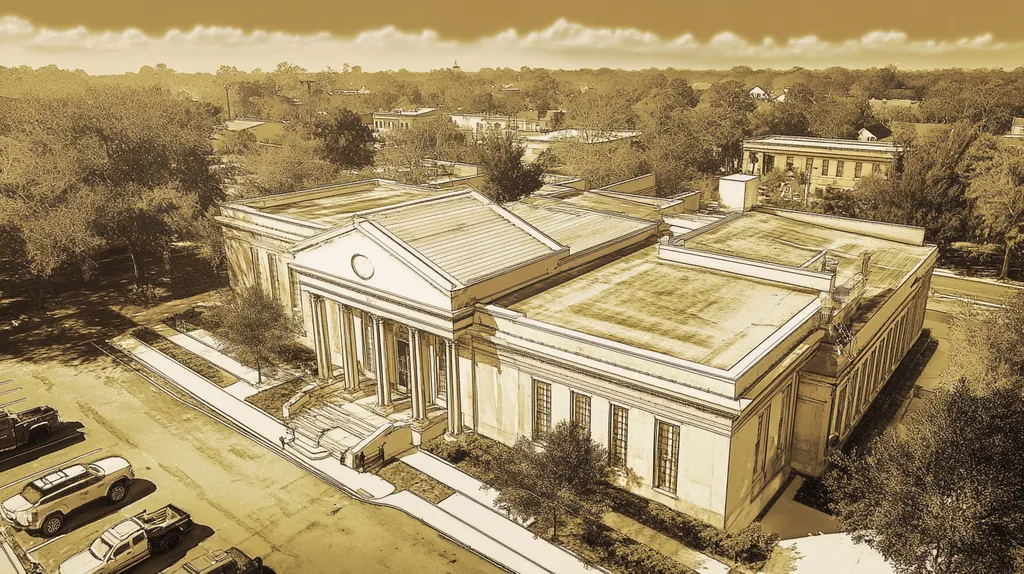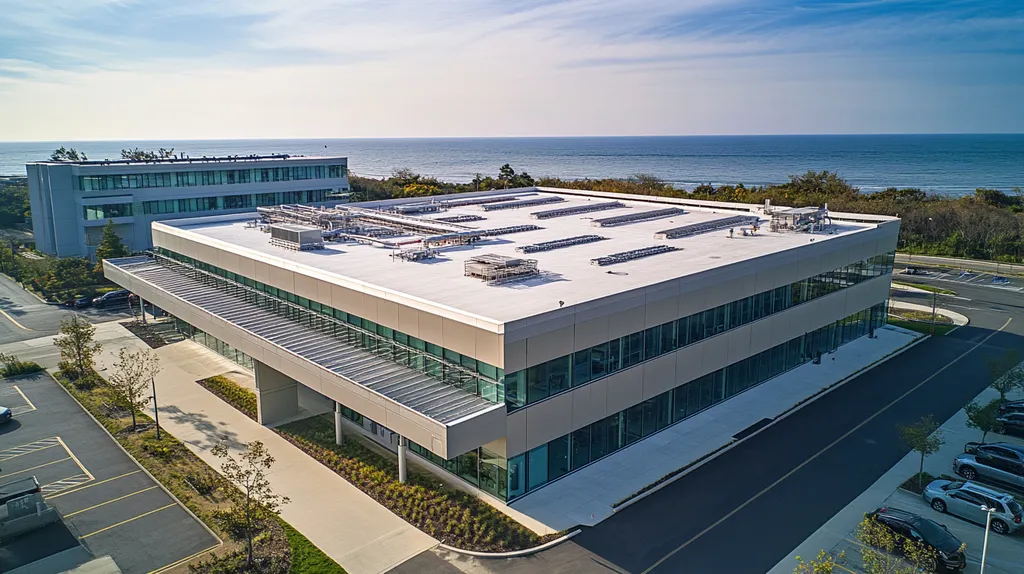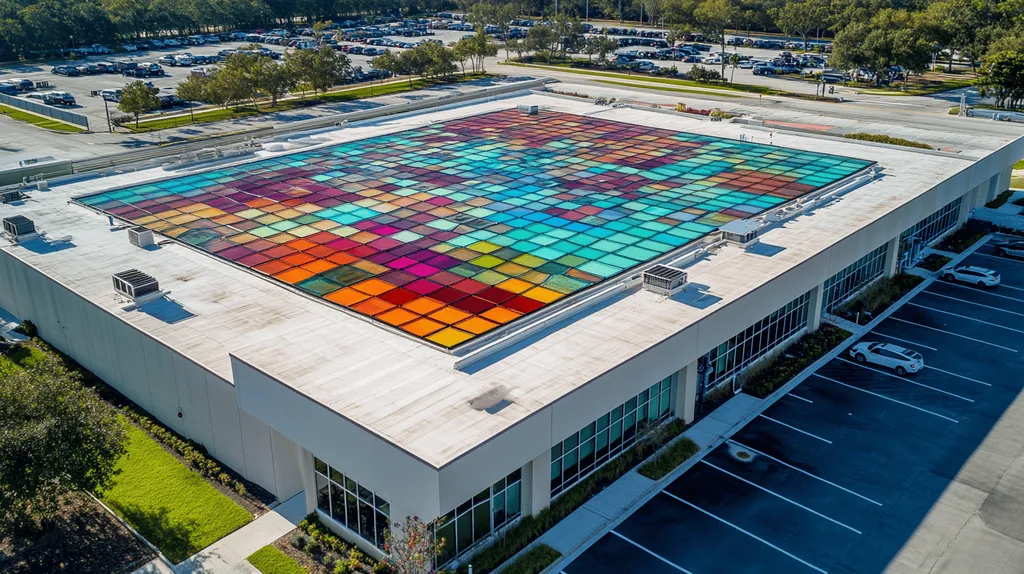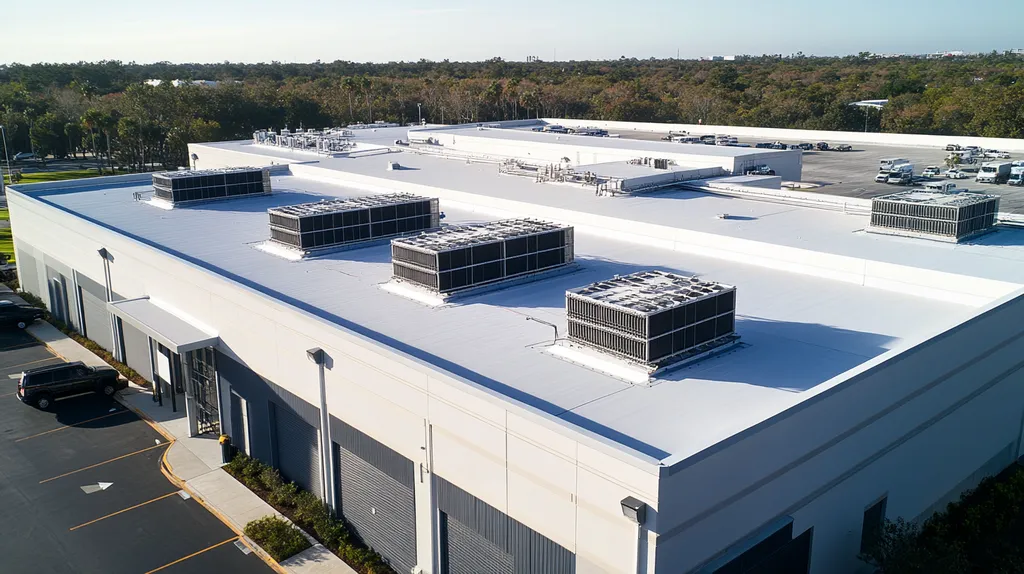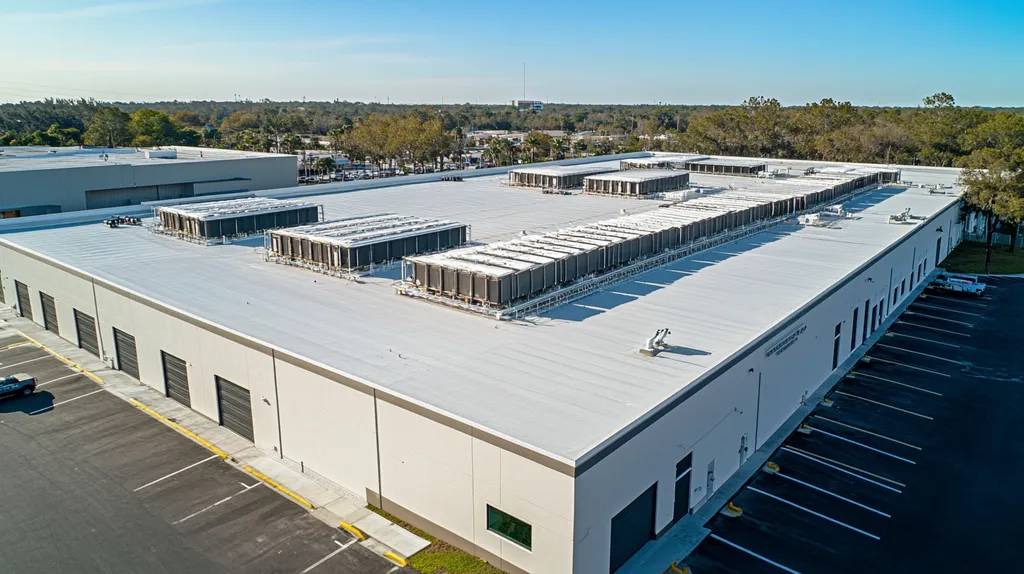Industrial roofing systems protect billions in assets, yet 40% of facilities struggle with premature coating failures that could have been prevented. These failures cost US businesses over $3.3 billion annually in repairs, energy waste, and operational disruptions.
Today’s facility managers face mounting pressure to optimize roof coating performance while balancing durability, costs, and compliance requirements. From material selection to installation procedures, each decision impacts the long-term success of industrial roofing systems.
This comprehensive guide provides facility managers with actionable solutions across six critical areas: performance factors, financial considerations, compliance requirements, risk management, operational procedures, and long-term planning.
SECTION 1: PERFORMANCE FACTORS
Every industrial facility encounters the critical task of keeping its roof in top shape. A properly maintained roof coating not only shields the building but also influences energy costs and the roof’s overall lifespan. Alarmingly, studies show that about 30% of roofs fail prematurely, often due to poor material choices and neglecting maintenance. This section highlights essential performance factors to consider when replacing industrial roof coatings, focusing on material durability, energy efficiency, and water resistance.
Roof Material Durability
Durability serves as the foundation of any effective roof coating. Selecting the right materials can greatly extend the roof’s lifespan. For example, coatings that use advanced polymers regularly outlast their traditional counterparts.
High-quality options like polyurethane or silicone coatings offer excellent resistance to cracking and deterioration. Designed to withstand harsh UV rays and extreme weather, these coatings are essential for long-term performance.
Regular wear-and-tear inspections can prevent costly premature failures. Facilities that make inspections a priority save significantly on repairs and replacements over time.
Key Action Items
Energy Efficiency and Reflectance
Energy efficiency is a vital aspect in selecting roof coatings. Reflective coatings can dramatically lower energy consumption by reducing heat absorption, making them especially advantageous in warmer regions.
For instance, opting for a roof coating with a high Solar Reflective Index (SRI) can slash cooling costs by as much as 15%. This not only translates into lower utility bills but also enhances the facility’s overall sustainability.
Additionally, many utility providers offer incentives for using energy-efficient roofing systems. This financial benefit underlines the significance of considering energy reflectance in coating choices.
Key Action Items
Water Resistance and Drainage
Water resistance is another key performance factor that needs utmost attention. Roof coatings must offer exceptional water resistance to avert leaks, which can lead to substantial damage and expensive repairs.
Effective drainage systems also play a crucial role. Roofs designed with the correct slope and drainage features help prevent water pooling, thus prolonging the coating’s life.
Many facility managers underestimate the importance of routine maintenance and inspections. Identifying water-related issues early can spare facilities from enormous financial setbacks.
Key Action Items
SECTION 2: FINANCIAL CONSIDERATIONS
Investing in an industrial roof coating is more than a cosmetic choice; it’s a smart financial strategy that can influence a facility’s profitability. Research reveals that roofs lacking proper care lead to costly repairs and disruptions in operations. Facility managers need to carefully consider initial installation costs, ongoing maintenance expenses, and potential energy savings to make informed decisions that boost both performance and financial success.
Initial Installation Costs
The upfront cost for installing an industrial roof coating can vary significantly based on the material, roof size, and project complexity. Typically, a facility might invest anywhere from $1.50 to $4.50 per square foot. Choosing lower-cost materials might seem tempting, but a smart investment in high-quality options often translates to substantial long-term benefits.
Quality materials usually come with longer warranties, significantly reducing future costs. For instance, a properly installed elastomeric coating can last over 15 years with minimal upkeep, while cheaper alternatives might need replacing or extensive repairs within a few short years.
Installation expenses may also be reduced through grants or rebates from energy efficiency programs, aimed at promoting sustainable practices. Facility managers should investigate local and federal programs to make the most of their budget, ensuring that careful analysis of initial investment pays off down the road.
Key Action Items
Long-Term Maintenance Expenses
Considering long-term maintenance is vital, as it can greatly impact overall roofing expenses. Regular maintenance not only extends the lifespan of a roof coating but also prevents costly future repairs. Neglecting this essential upkeep can lead to significant setbacks down the road.
It’s advisable to schedule inspections at least twice a year to catch potential issues early. For example, a small crack can be fixed for just a few hundred dollars, whereas ignoring it could result in a costly complete coating failure.
Additionally, maintenance expenses may encompass cleaning and recoating tasks, which should factored into any financial planning. Coatings often require reapplication every 5 to 10 years. By anticipating these costs, facility managers can avoid budget overruns and ensure long-lasting roof performance.
Key Action Items
Potential Energy Savings
Energy efficiency is increasingly driving decisions around industrial roof coatings. Reflective coatings can drastically decrease energy consumption by lowering indoor temperatures. Research indicates that these roofs can lead to up to a 25% reduction in cooling costs, especially in hot climates.
The accumulated utility savings can quickly mount over time, resulting in significant annual cost reductions. The savings often outstrip the initial investment in a quality roof coating, making it a highly beneficial upgrade. Furthermore, some coatings are eligible for energy efficiency rebates, enhancing their financial appeal.
Incorporating energy-efficient roofing solutions contributes to sustainability goals as firms face growing pressure to reduce their carbon footprints. Facilities featuring advanced roofing systems not only save money but also gain higher attention from prospective buyers or tenants, ensuring a strong return on investment.
Key Action Items
SECTION 3: COMPLIANCE REQUIREMENTS
Maintaining compliance with industry regulations during the replacement of industrial roof coatings is not just a formality—it’s a necessity. Failure to adhere can lead to tough penalties, unsafe work conditions, and damage to a facility’s reputation. The National Roofing Contractors Association estimates that non-compliance can increase project costs by up to 20% due to delays and fines. To ensure the success of a roofing project, facility managers must not only grasp building codes but also familiarize themselves with warranty standards and environmental regulations.
Building Code Adherence
Building codes are essential blueprints that guarantee safety and quality in roofing projects. These codes vary by jurisdiction and define specific materials and installation methods that must be followed. Ignoring these regulations can result in project rejection and costly penalties.
Before starting any roofing project, facility managers should engage with local building authorities. This proactive step can help prevent violations, fines, or even the need to redo non-compliant work. Codes are regularly updated, making it crucial to work with knowledgeable contractors.
Documenting compliance is equally important—keeping track of permits, inspection reports, and all correspondence with regulatory bodies can facilitate smooth audits and support insurance claims if necessary. Prioritizing compliance not only impacts immediate safety but also protects against legal liabilities.
Key Action Items
Warranty and Certification Standards
Warranties and certifications are critical components in ensuring a roof’s durability and performance. Many manufacturers provide warranties that become void if installation guidelines are not followed meticulously, leading to unexpected costs for repairs or replacements.
Facility managers should insist on certified materials and qualified contractors. Having certifications from recognized organizations, such as the Roof Consultant Institute (RCI), ensures adherence to quality standards and best practices in installations. Using certified materials reduces the risk of untimely roof failures.
Conducting thorough due diligence while choosing roofing products is key. Managers should review warranty documents carefully and validate contractor qualifications to secure significant long-term savings. Aligning with warranty standards enhances a facility’s operational integrity and reliability.
Key Action Items
Regulatory Environmental Compliance
Environmental regulations are increasingly shaping the landscape of roofing projects, especially in terms of material selection and waste disposal. Compliance with regulations set by organizations like the Environmental Protection Agency (EPA) can substantially influence project costs and timelines.
Facility managers should familiarize themselves with both state and federal regulations regarding hazardous materials and proper waste management practices. Efficient waste handling not only minimizes environmental impact but also helps avert reputational damage and potential fines.
Opting for eco-friendly roofing solutions can meet regulatory requirements while offering eligibility for financial incentives. Energy-efficient systems not only reduce operational costs but also align with sustainability goals, boosting the facility’s appeal.
Key Action Items
SECTION 4: RISK MANAGEMENT
Effective risk management is essential when replacing industrial roof coatings. Neglecting leaks and damage can lead to hefty repair costs and significant operational interruptions. Alarmingly, water intrusion is responsible for nearly 90% of roofing failures. To safeguard against these risks, facility managers must be vigilant in identifying potential issues, mitigating the impacts of severe weather, and ensuring the long-term structural integrity of their roofs.
Identifying Potential Leaks and Damage
Spotting leaks and damage early can be a game-changer for industrial roofs. Regular inspections should focus on critical areas like seams, joints, and roof penetrations, where water is most likely to enter and cause damage.
Utilizing innovative technology such as infrared thermography enables facility managers to detect moisture hidden beneath the roof surface during inspections. This proactive approach can prevent minor issues from escalating into expensive repairs.
Additionally, investing in user-friendly monitoring systems that deliver real-time data on roof condition can enhance responsiveness to emerging problems. Swift action against leaks and damage may save thousands in costly repairs and extend the roof’s service life. Lastly, keeping detailed documentation of inspections and repairs can reveal patterns of recurring issues, guiding informed coating decisions for future upgrades.
Key Action Items
Mitigating Weather-Related Risks
Weather can pose serious risks to industrial roofs, highlighting the need for effective mitigation strategies. Extreme temperatures may cause materials to expand and contract, leading to accelerated wear and tear. Understanding local weather patterns equips facility managers to prepare for these challenges.
Implementing weather-resistant materials increases a roof’s resilience against harsh conditions. For instance, installing reflective coatings helps lower rooftop temperatures, reducing thermal stress while saving on energy costs.
Preparing for inclement weather also involves ensuring proper drainage systems are in place. Clogged drains can cause water pooling, leading to leaks and structural damage. Regular maintenance of drainage components is vital before severe weather hits. Furthermore, fostering a culture of preparedness among staff through regular weather discussions can enhance organizational readiness and quick response to challenges.
Key Action Items
Ensuring Structural Integrity
Keeping the structural integrity of an industrial roof intact is vital in averting failures. Over time, elements such as age, environmental conditions, and heavy loads can compromise the roof’s strength. Conducting regular structural assessments is crucial to identify and address weaknesses.
Facility managers should schedule thorough evaluations to check for sagging, cracks, and material degradation. Engaging qualified engineers for these inspections ensures professional insights into the roof’s condition and safety.
Investing in reinforcement services—such as structural supports during a coating replacement—can significantly advance the roof’s longevity. Collaborating with roofing professionals who are aware of local building codes strengthens the commitment to maintaining structural integrity, ultimately leading to a resilient roofing solution.
Key Action Items
SECTION 5: OPERATIONAL PROCEDURES
The success of industrial roof coatings relies on well-defined operational procedures. Regular maintenance is the key to prolonging the life of these coatings and saving on costly repairs. The National Roofing Contractors Association (NRCA) estimates that proactive measures can lower roofing replacement costs by as much as 40%. To protect their investments, facility managers must focus on inspection schedules, debris removal, and post-installation evaluations.
Regular Inspection Schedules
Setting a consistent schedule for roof inspections is vital for maintaining industrial roof coatings. Inspections should occur at least twice a year, and even more frequently after severe weather events. This proactive approach helps identify potential issues before they worsen, ultimately preserving the coating’s integrity.
Facility managers should focus on critical signs of wear, such as cracks, blisters, or UV damage during inspections. Quick identification of these problems allows for timely repairs, preventing minor cracks from escalating into significant moisture intrusion issues.
It’s essential to document inspection findings. Keeping records of issues and repairs creates a historical overview that aids in future maintenance decisions and budgeting. Ultimately, adhering to a routine inspection schedule is an investment in the longevity and reliability of the roofing system.
Key Action Items
Debris Removal and Cleaning
Accumulated debris can significantly impair the performance of an industrial roof coating. Leaves, dirt, and contaminants can trap moisture, accelerating deterioration. Therefore, routine debris removal is essential to keeping the coating effective.
Cleaning should be integrated into a regular maintenance plan, occurring at least twice a year. A clean surface facilitates better adhesion during repairs and boosts coating performance. For example, ridding the roof of algae and moss prevents further growth that could damage the material.
Facility managers must choose appropriate cleaning methods that won’t harm the coating. While high-pressure washing is effective, it could potentially damage sensitive surfaces if not performed correctly. It’s best to consult professionals who are experienced with industrial roof coatings.
Key Action Items
Post-Installation Inspections
Conducting post-installation inspections is crucial to confirm that newly applied roof coatings meet industry standards and manufacturer specifications. These inspections should take place shortly after installation and again following the drying and curing process.
Facility managers need to ensure that the coating has been applied evenly and that no inconsistencies exist. Any defects found during this period can typically be remedied at little or no additional cost, while the work remains under warranty.
Additionally, these inspections provide valuable feedback on the installation team’s performance. This assessment can inform future contractor selections and improve overall project outcomes. By emphasizing this evaluation process, facility managers promote accountability and quality in their roofing projects.
Key Action Items
SECTION 5: OPERATIONAL PROCEDURES
The success of industrial roof coatings hinges on rigorous operational procedures. Regular maintenance significantly extends the life of these coatings and prevents costly damage. According to the National Roofing Contractors Association (NRCA), proactive measures can reduce roofing replacement costs by up to 40%. Facility managers must prioritize inspection schedules, debris removal, and post-installation evaluations to safeguard their investments.
Regular Inspection Schedules
Establishing a consistent inspection schedule is essential for maintaining industrial roof coatings. Facility managers should conduct inspections at least twice a year and after any severe weather events. This proactive approach helps catch potential issues early, preserving the coating’s integrity.
During these inspections, look for critical signs of wear, such as cracks, blisters, or UV damage. Addressing minor issues quickly can prevent more significant problems, like moisture intrusion, from developing.
Documentation is crucial—recording inspection findings builds a historical overview that aids future maintenance decisions. Ultimately, sticking to a regular inspection schedule is not just smart—it’s an investment in the longevity and reliability of the roofing system.
Key Action Items
Debris Removal and Cleaning
Accumulated debris can significantly hinder the performance of industrial roof coatings. Leaves, dirt, and other contaminants can trap moisture, accelerating deterioration. Therefore, routine debris removal is vital for maintaining the coating’s effectiveness.
Cleaning should be part of a regular maintenance plan, ideally happening at least twice a year. A clean roof surface facilitates better repair adhesion and enhances overall coating performance. For instance, removing algae and moss prevents further degradation of the roof material.
Facility managers should employ safe cleaning techniques that won’t damage the coatings. While high-pressure washing can be effective, it must be done carefully to avoid harming sensitive surfaces. Consulting professionals experienced with industrial roof coatings is smart for optimal results.
Key Action Items
Post-Installation Inspections
Post-installation inspections are crucial to ensure that newly applied roof coatings meet industry standards and manufacturer specifications. These inspections should take place shortly after application and again once the coating has dried and cured.
During these reviews, facility managers must confirm that the coating has been applied evenly with no inconsistencies present. Addressing any defects during this period is usually straightforward and often incurs little to no additional cost due to warranty coverage.
These inspections also provide an opportunity to evaluate the installation team’s performance, guiding future contractor selections and improving project outcomes. Implementing this evaluation process fosters accountability and enhances the quality of roofing installations.
Key Action Items
Looking Ahead
With over $3.3 billion lost annually to preventable roof coating failures, facility managers can’t afford to take a reactive approach to industrial roofing maintenance.
The data shows that implementing comprehensive inspection schedules reduces replacement costs by up to 40%, while proper coating selection can slash energy expenses by 25% or more.
Success requires balancing performance factors, financial considerations, compliance requirements, risk management strategies, and operational procedures.
By following industry best practices for material selection, installation oversight, and ongoing maintenance, facilities can extend coating lifespans by 5-10 years while optimizing ROI.
The future of industrial roofing lies in proactive management – those who adapt these strategies today will see dramatic cost savings tomorrow.
FREQUENTLY ASKED QUESTIONS
Q. What key performance factors should I consider for my industrial roof?
A. For your industrial roof, focus on material durability, energy efficiency, and water resistance. Choosing high-quality coatings can extend the lifespan, reduce energy costs, and prevent leakage. Regular inspections are essential to catch potential issues early and maintain optimal performance.
Q. How do initial installation costs impact my commercial roof project?
A. Initial installation costs can vary based on materials and roof size but investing in quality can save money over time. Higher-quality materials often come with longer warranties and fewer replacement needs, ensuring a better long-term financial outcome for your project.
Q. What compliance requirements should I know for commercial roofs?
A. Compliance requirements include adhering to building codes, ensuring warranties are followed, and meeting environmental regulations. Engage local authorities and document all compliance activities to prevent penalties and ensure the success of your roofing project.
Q. How can I manage risks associated with industrial roofing?
A. Effective risk management involves regular inspections, prompt leak detection, and choosing weather-resistant materials. Proactive assessments and maintenance can significantly reduce damage and costs associated with roofing failures, ensuring long-term structural integrity.
Q. What are the best operational procedures for my industrial roof?
A. Implement regular inspection schedules, ensure debris removal, and perform post-installation evaluations. These procedures help maintain the roof’s integrity and performance, preventing costly repairs and extending the lifespan of your coatings.
Q. How often should I schedule inspections for my commercial roof?
A. Schedule inspections at least twice a year and after severe weather events. This frequency helps catch potential issues early, keeping your roof in optimal shape and saving on future repair costs.
Q. What signs indicate that my industrial roof needs immediate attention?
A. Look for cracks, blisters, or signs of water pooling. These issues, along with visible wear and tear, signal that your roof needs immediate attention to avoid significant damage and costly repairs.


